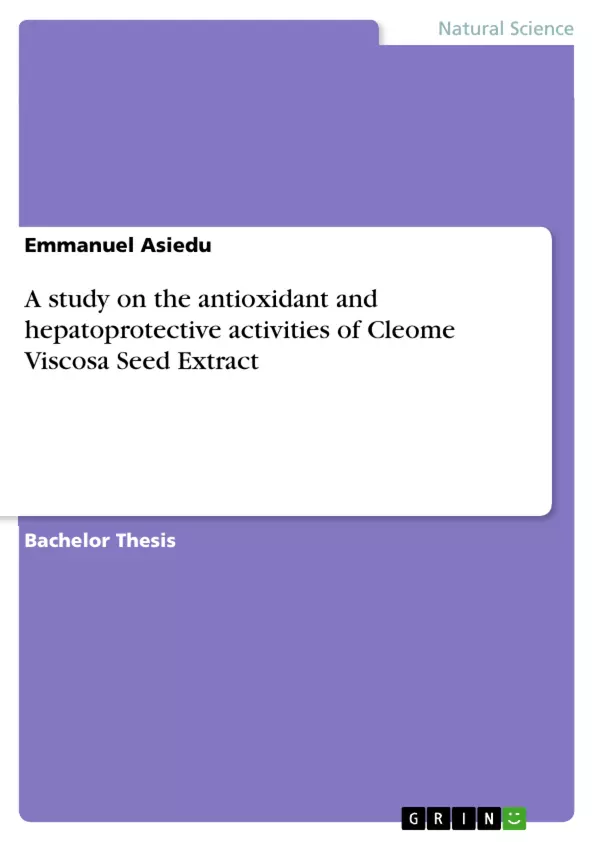Objectives of this studie are: to determine the Phytochemical constituents of the seed extract, to evaluate the hepatoprotective activity of Cleome viscosa seed extract against carbon tetrachloride induced hepatotoxicity in experimental animal models, to determine the antioxidant activity of the seed extract of Cleome viscosa and to compare the antioxidant potential of the extract with the standard.
Liver diseases are mainly caused by toxic chemicals, over dose of drugs such as carbon tetrachloride and excessive consumption of alcohol. Previous studies have shown that liver damages have been induced by hepatotoxic chemicals such as carbon tetrachloride. This give rise to serum level AST and ALT and cholesterol which give rise to damage of structural integrity of the liver cells.
Cellular ageing and inflammatory diseases have been caused by free radicals. Free radicals are reactive species of oxygen. Free radicals also lead to oxidative stress which is defined as loss of balance between oxidizing and antioxidant agents within the cell.
The plant has traditionally been used for hepatoprotective activities, hence this research intends to validate the plant hepatoprotective activity. The abundance and the numerous medicinal properties of the plant has also urge us to undertake this study.
Inhaltsverzeichnis (Table of Contents)
- CHAPTER ONE
- INTRODUCTION
- 1.1 BACKGROUND
- 1.2 PROBLEMS STATEMENT/JUSTIFICATION
- 1.3 AIM OF PROJECT WORK
- 1.4 OBJECTIVES OF PROJECT WORK
- 1.5 SIGNIFICANCE OF PROJECT WORK
- CHAPTER TWO
- LITERATURE REVIEW
- 2.1 ANTIOXIDANT STUDY
- 2.1.1 Mechanism of Antioxidants
- 2.1.2 Classification of Antioxidants
- 2.1.3 Concept of Oxidative Stress
- 2.1.5 Generation of Free Radicals
Zielsetzung und Themenschwerpunkte (Objectives and Key Themes)
This project investigates the antioxidant and hepatoprotective properties of Cleome viscosa seed extract. The study aims to evaluate the potential of Cleome viscosa seeds as a therapeutic agent for preventing oxidative stress and liver damage.
- Phytochemical analysis of Cleome viscosa seeds extract
- Evaluation of the antioxidant activity of the extract using DPPH radical scavenging and DNA protection assays
- Investigation of the hepatoprotective effects of the extract against carbon tetrachloride-induced liver toxicity in rats
- Histopathological analysis of liver tissues to confirm the hepatoprotective activity
- Assessment of the potential of Cleome viscosa seeds as a natural source of antioxidants and hepatoprotective agents
Zusammenfassung der Kapitel (Chapter Summaries)
Chapter one introduces the background of the study, focusing on the medicinal properties of Cleome viscosa and its potential use as a therapeutic agent. It outlines the problem statement, research objectives, and significance of the project. Chapter two reviews the existing literature on antioxidants, oxidative stress, and hepatoprotective agents, providing a comprehensive overview of the scientific knowledge surrounding these topics. This chapter focuses on the mechanism of antioxidants, their classification, and the generation of free radicals.
Schlüsselwörter (Keywords)
The key terms and concepts explored in this study include Cleome viscosa, antioxidant activity, hepatoprotective activity, phytochemical analysis, DPPH radical scavenging, DNA protection assay, carbon tetrachloride-induced liver toxicity, histopathology, and oxidative stress. These keywords highlight the primary areas of research and the potential benefits of Cleome viscosa seeds as a natural therapeutic agent.
- Citation du texte
- Emmanuel Asiedu (Auteur), 2018, A study on the antioxidant and hepatoprotective activities of Cleome Viscosa Seed Extract, Munich, GRIN Verlag, https://www.grin.com/document/981373



